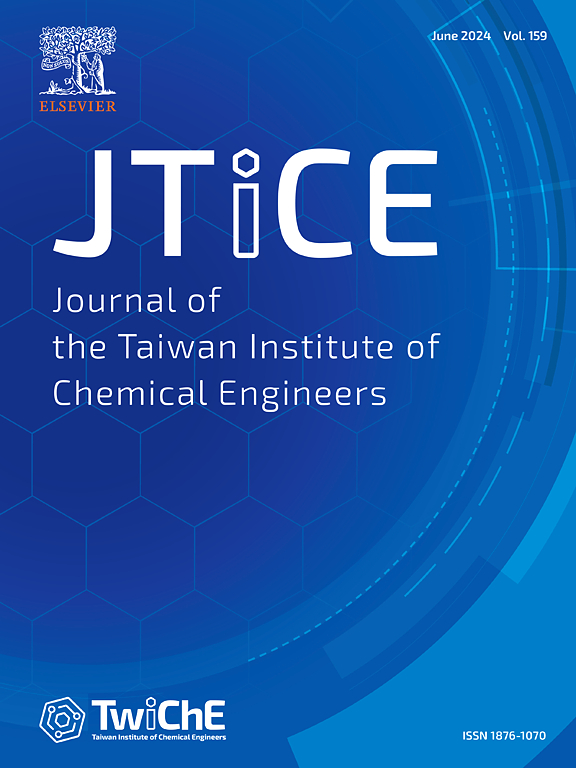Efficient and selective capture of lead ions by a covalent organic framework: Structure, performance and mechanism
IF 5.5
3区 工程技术
Q1 ENGINEERING, CHEMICAL
Journal of the Taiwan Institute of Chemical Engineers
Pub Date : 2025-03-30
DOI:10.1016/j.jtice.2025.106108
引用次数: 0
Abstract
Background
In recent years, lead contamination in aquatic environments has become a significant concern. Covalent organic frameworks (COFs) have shown great potential in preventing and remediating water pollution due to their superior performance characteristics.
Methods
DHTA-TAPA COF was synthesized via a solvothermal method through the condensation reaction between tris(4-aminophenyl) amine (TAPA) and 2,5-dihydroxyterephthalaldehyde (DHTA). The effects of parameters such as pH, initial ion concentration, temperature, and adsorption duration on the efficiency of Pb2+ removal by DHTA-TAPA COF were investigated.
Findings
A novel imine-linked covalent organic framework (DHTA-TAPA COF) has been successfully synthesized, which exhibits an exceptionally high theoretical Pb²⁺ adsorption capacity of 472.19 mg/g and demonstrates outstanding selective adsorption for lead ions, even in the presence of competing heavy metal ions. The unique structure of the COF, rich in nitrogen and oxygen functional groups, facilitates strong coordination and chelation interactions with Pb²⁺ during the adsorption process, ensuring stable immobilization of lead ions. Remarkably, after five consecutive adsorption-desorption cycles, the adsorption capacity decreased by only 15%, underscoring its excellent regenerability and practical potential as a high-performance adsorbent for the remediation of lead-contaminated water.
共价有机框架对铅离子的高效和选择性捕获:结构、性能和机理
近年来,水生环境中的铅污染已成为一个令人关注的问题。共价有机框架(COFs)由于其优越的性能特点,在防治和修复水污染方面显示出巨大的潜力。方法以三(4-氨基苯基)胺(TAPA)和2,5-二羟基对苯二甲酸(DHTA)为原料,采用溶剂热法缩合合成DHTA-TAPA COF。考察了pH、初始离子浓度、温度、吸附时间等参数对DHTA-TAPA COF去除Pb2+效果的影响。成功合成了一种新型亚胺键合共价有机框架(DHTA-TAPA COF), pb2 +的理论吸附容量高达472.19 mg/g,即使在竞争的重金属离子存在的情况下,也能对铅离子表现出出色的选择性吸附。COF独特的结构,富含氮氧官能团,在吸附过程中与Pb 2 +具有强的配位和螯合作用,确保了铅离子的稳定固定化。值得注意的是,在连续5次吸附-解吸循环后,吸附量仅下降15%,表明其具有良好的可再生性和作为铅污染水体修复的高性能吸附剂的应用潜力。
本文章由计算机程序翻译,如有差异,请以英文原文为准。
求助全文
约1分钟内获得全文
求助全文
来源期刊
CiteScore
9.10
自引率
14.00%
发文量
362
审稿时长
35 days
期刊介绍:
Journal of the Taiwan Institute of Chemical Engineers (formerly known as Journal of the Chinese Institute of Chemical Engineers) publishes original works, from fundamental principles to practical applications, in the broad field of chemical engineering with special focus on three aspects: Chemical and Biomolecular Science and Technology, Energy and Environmental Science and Technology, and Materials Science and Technology. Authors should choose for their manuscript an appropriate aspect section and a few related classifications when submitting to the journal online.

 求助内容:
求助内容: 应助结果提醒方式:
应助结果提醒方式:


